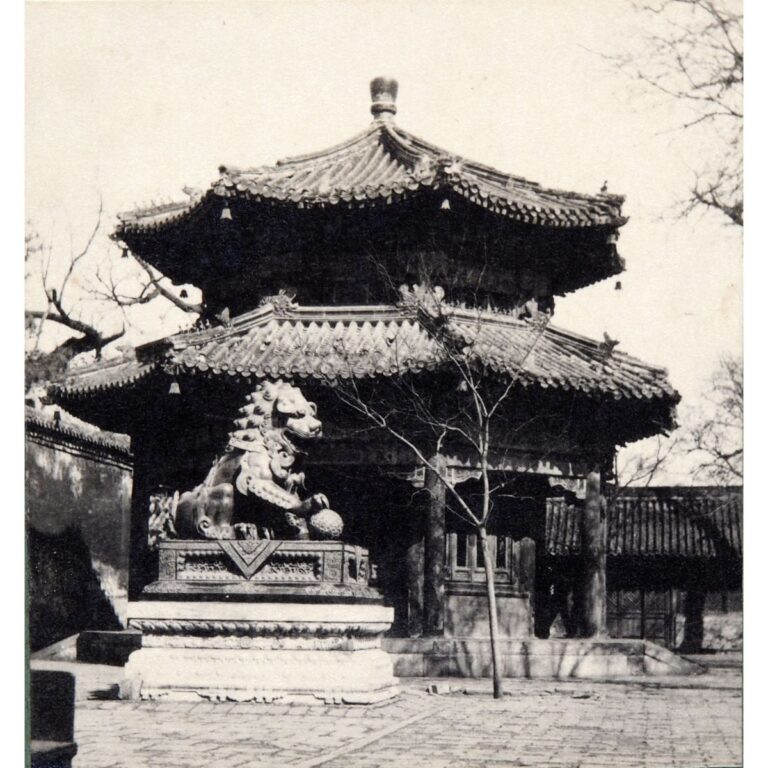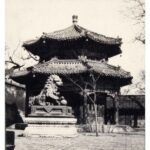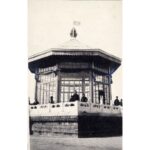Photography Stele Pavilion in Yonghe Temple
A photograph showing the eastern octagonal pavilion for the stele beiting 碑亭 and the lion guardian shishi 石獅 at the Lamaist Yonghe Temple (Yonghe Gong 雍和宫) or “Temple of Tranquility and Harmony” in Beijing. During the Qing Dynasty, it was the seat of Tibetan dignitaries and housed nearly a thousand monks. The photo shows one of the two beiting stele pavilions located in the inner courtyard in front of the entrance to the main temple. It houses a stele with a text on Tibetan Buddhism written by Emperor Qianlong (reigned 1735–1796) in 1744. The text is written in Manchu on the right-hand side and Chinese on the left. On the western stele, the same text is also written in Mongolian and Tibetan. Next to the pavilion is a statue of a bronze lion guardian. Usually, a lion guardian would stand together with a female holding a cub under her paw, although this is not visible in this photo. In front of the entrances to the buildings are statues in the form of a mythological ... more
A photograph showing the eastern octagonal pavilion for the stele beiting 碑亭 and the lion guardian shishi 石獅 at the Lamaist Yonghe Temple (Yonghe Gong 雍和宫) or “Temple of Tranquility and Harmony” in Beijing. During the Qing Dynasty, it was the seat of Tibetan dignitaries and housed nearly a thousand monks. The photo shows one of the two beiting stele pavilions located in the inner courtyard in front of the entrance to the main temple. It houses a stele with a text on Tibetan Buddhism written by Emperor Qianlong (reigned 1735–1796) in 1744. The text is written in Manchu on the right-hand side and Chinese on the left. On the western stele, the same text is also written in Mongolian and Tibetan. Next to the pavilion is a statue of a bronze lion guardian. Usually, a lion guardian would stand together with a female holding a cub under her paw, although this is not visible in this photo. In front of the entrances to the buildings are statues in the form of a mythological half-lion/half-dog.
The octagonal pavilion was built using the traditional Chinese construction technique, the dougong 斗拱 system. In addition to dowels in the eaves, other features of Chinese construction include roof shapes, glazed tiles, and the use of colours, numbers, and decorative animal figures. The octagon is decorated with glazed tiles and decorative figures – a larger finial is at the top of the upper roof, with smaller figures in a strict order on the side eaves. The eaves are decorated with dowels or wooden joints. The first three bands below them are yellow, green, and blue.
The lion guardian holds an orb under his paw. The lion guardian motif is a popular concept in Chinese Buddhism. It probably evolved from the depiction of dogs as protectors of the Dharma in India. Stylised lions stood at the entrances of tombs, palaces, and government buildings in China and other Buddhist sites in Asia. The oldest statues in China date back to the 3rd century B.C. They are supposed to protect buildings from evil spirits and human actions.
The Manchu rulers promoted Tibetan Buddhism (or Lamaism) and encouraged visits by high religious dignitaries and the construction of many Tibetan temples in and around Beijing. Covering an area of nearly seven hectares, Yonghe Temple is the largest of them, with 661 separate rooms, nearly half of which are dedicated to the worship of the Buddha and the performance of rituals. The temple complex stood in the northeastern part of the Inner City (Neicheng 内城) at the northern end of the long avenue Chongwenmen Dajie 崇文門大街, more commonly called Hademen Dajie 哈德門大街 in the west. The building was first used by Manchu princes. In 1744, Emperor Qianlong had the palace converted into a temple. During his reign, 1,500 Tibetan and Mongolian lamas lived here. The temple has been a designated cultural heritage site since 1949 and is open to the public.
The photograph is the 192nd of 449 photographs of Beijing and its surroundings in the album of Ivan Skušek Jr., purchased during his stay in Beijing (1914–1920). In the handwritten inventory of the album, the photograph is referred to as Lama-Kloster: Bronze-Löwe und Paiting. (DZ, MV)





































Do you have a comment or additional information about the subject?